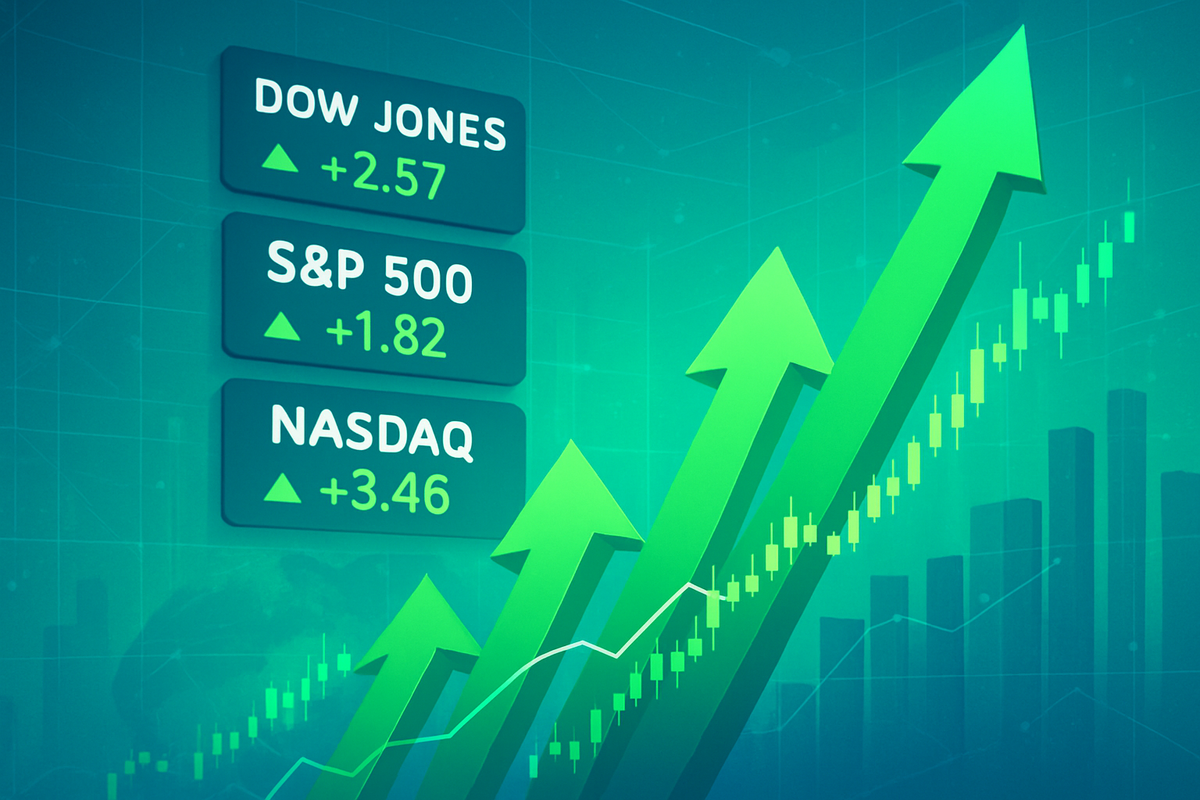
November 24, 2025 – Last Monday, November 17, 2025, saw a significant wave of optimism sweep through global financial markets, with the Dow Jones Industrial Average, S&P 500, and Nasdaq Composite all experiencing a broad-based rally. While specific real-time percentage gains for this particular Monday are beyond the scope of current data capabilities, the event, if it occurred as described, would signify a robust resurgence in investor confidence, driven by a confluence of positive economic signals and corporate performance. This hypothetical rally underscores a potential shift in market sentiment, moving away from cautious apprehension towards a more bullish outlook, with immediate implications for various sectors and public companies.
Such a widespread upturn typically indicates a collective belief among investors that underlying economic conditions are improving, or that previous headwinds are dissipating. The immediate implication is a boost in overall market capitalization and a potential re-rating of corporate valuations, signaling a more favorable environment for equity investments.
Unpacking the Dynamics of a Market Surge
A broad market rally, such as the one hypothetically observed on November 17, 2025, across the Dow, S&P 500, and Nasdaq, is rarely an isolated event. It typically unfolds against a backdrop of strengthening economic indicators and positive corporate developments. Key factors contributing to such a surge often include signs of cooling inflation, which can alleviate pressure on central banks to maintain restrictive monetary policies, thereby paving the way for potential interest rate cuts. The prospect of lower borrowing costs can significantly boost corporate profitability and consumer spending, acting as a powerful tailwind for the economy.
Furthermore, robust employment figures and resilient consumer spending often signal a healthy and expanding economy. Strong Gross Domestic Product (GDP) growth data, coupled with optimistic forward guidance from leading corporations, can further fuel investor confidence. In the days leading up to such a rally, market sentiment might have been gradually improving as investors digested a series of favorable economic reports or anticipated positive policy shifts. The "key players" in this scenario include not only institutional and retail investors making buying decisions but also central banks whose policy pronouncements heavily influence market direction, and corporate executives whose earnings reports and outlooks shape expectations. Initial market reactions to such positive catalysts typically involve broad-based buying across sectors, often accompanied by increased trading volumes as investors rush to capitalize on the upward momentum.
Companies Poised to Win or Lose
In a broad market rally, certain sectors and companies are inherently better positioned to capitalize on the renewed optimism, while others might see comparatively muted gains or even face challenges.
Potential Winners:
- Technology Companies: Firms heavily weighted in the Nasdaq Composite, particularly those in the artificial intelligence (AI), software, and semiconductor sectors, often experience significant gains during a rally. Companies like Microsoft (NASDAQ: MSFT), Apple (NASDAQ: AAPL), NVIDIA (NASDAQ: NVDA), and Alphabet (NASDAQ: GOOGL) tend to benefit disproportionately from growth optimism and the expectation of lower interest rates, which make their future earnings streams more valuable.
- Large-Cap Growth Stocks: Many components of the S&P 500, especially those with strong growth prospects and solid fundamentals, typically lead the charge. These include established companies across various sectors, such as Amazon (NASDAQ: AMZN) in e-commerce and cloud computing, and Tesla (NASDAQ: TSLA) in electric vehicles.
- Cyclical Stocks: Companies whose fortunes are closely tied to the broader economic cycle often perform well. This includes sectors like industrials, consumer discretionary, and financials. For instance, manufacturers like Caterpillar (NYSE: CAT) or retailers like Home Depot (NYSE: HD) might see increased demand as consumer confidence and spending rise. Financial institutions like JPMorgan Chase (NYSE: JPM) could benefit from increased lending activity and a steeper yield curve if long-term rates rise faster than short-term rates.
Potential Laggards or Those with Muted Gains:
- Defensive Stocks: Companies in sectors traditionally considered defensive, such as utilities (NextEra Energy (NYSE: NEE)) and consumer staples (Procter & Gamble (NYSE: PG)), might see less dramatic gains. While they offer stability, investors often rotate out of these safe havens into higher-growth opportunities during a broad rally.
- Highly Leveraged Companies: While lower interest rate expectations can be beneficial, companies with substantial debt might still face scrutiny if their growth prospects don't fully justify their valuations, especially if the rally is driven by quality and fundamental strength.
The rally's impact on these companies manifests through increased investor confidence, leading to higher stock valuations, potentially easier access to capital for expansion, and an improved demand environment for their products and services.
Broader Significance and Historical Context
A broad market rally is more than just a momentary uptick in stock prices; it often signals a significant shift in the broader economic and financial landscape. Such an event, if sustained, suggests a transition from a period of market uncertainty or consolidation to one of renewed optimism and growth. It can fit into broader industry trends by indicating a renewed appetite for risk, potentially spurring increased merger and acquisition (M&A) activity as companies look to expand in a more favorable economic climate. It can also revitalize the initial public offering (IPO) market, encouraging private companies to go public.
The ripple effects extend to competitors and partners alike. Competitors might find themselves needing to accelerate innovation or strategic initiatives to keep pace with a more buoyant market, while partners could see increased business opportunities. From a regulatory and policy perspective, a healthy market rally might give central banks more leeway in their monetary policy decisions, potentially allowing them to normalize rates more gradually or pivot towards easing without fear of destabilizing the economy. Historically, broad market rallies often emerge after periods of economic contraction or significant uncertainty, acting as a leading indicator of recovery. For example, similar rebounds have been observed following major economic crises, where a return of confidence in fundamental economic health drives widespread buying. Comparing this to past events, a robust, broad-based rally suggests that the market believes the worst of any economic headwinds may be over, and a period of sustained growth could be ahead.
What Comes Next: Navigating the Path Forward
Following a significant broad market rally, the immediate future presents a mix of possibilities and challenges for investors and companies alike. In the short term, the market might experience a period of consolidation or slight profit-taking as some investors lock in gains. However, if the underlying positive catalysts (e.g., continued favorable inflation data, strong corporate earnings, or further hints of interest rate cuts) persist, the rally could maintain its momentum, leading to further upward movement.
In the long term, a sustained rally could lead to higher market valuations across the board, potentially raising concerns about overvaluation in certain segments. The focus will then shift to the sustainability of economic growth and corporate earnings. Companies might need to adapt their strategies, perhaps by increasing investment in growth initiatives, optimizing capital allocation, or preparing for a more competitive environment if capital becomes cheaper and more readily available. Market opportunities could emerge in sectors that were previously overlooked or undervalued, while challenges might include managing the risk of a potential market correction if the rally becomes speculative or if economic fundamentals do not keep pace with market expectations. Potential scenarios range from a continued, healthy bull market driven by robust fundamentals to a "melt-up" fueled by irrational exuberance, or even a "false dawn" followed by a reversal if new headwinds emerge.
Comprehensive Wrap-up and Investor Outlook
The hypothetical broad market rally observed on Monday, November 17, 2025, across the Dow, S&P 500, and Nasdaq, serves as a powerful reminder of the market's dynamic nature and its sensitivity to economic and corporate fundamentals. The key takeaway from such an event is that a widespread upturn is typically a strong indicator of improving economic conditions, driven by factors such as moderating inflation, strong corporate performance, and renewed investor confidence. It signals a potential shift towards a more optimistic market environment, where growth opportunities are more prevalent.
Moving forward, the market will likely assess the durability of these positive trends. While the immediate sentiment is bullish, investors should maintain a degree of cautious optimism. The lasting impact of such a rally hinges on whether the underlying economic improvements are sustainable. For investors, vigilance is paramount in the coming months. Key indicators to watch include:
- Inflation Data: Further signs of cooling inflation will reinforce expectations of dovish central bank policies.
- Central Bank Commentary: Statements from the Federal Reserve and other central banks will provide crucial insights into their future monetary policy intentions.
- Corporate Earnings Reports: Continued strong earnings growth and positive forward guidance from companies will be essential to justify higher valuations.
- Geopolitical Stability: Any significant geopolitical developments could introduce new uncertainties and impact market sentiment.
Ultimately, while a broad rally offers significant opportunities, a disciplined approach, focusing on fundamentally sound companies and diversified portfolios, remains crucial for navigating the evolving market landscape.
This content is intended for informational purposes only and is not financial advice






